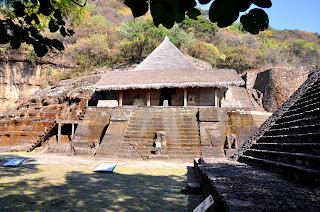Perched atop a sheer ridge, 1,800 feet above the town
of Malinalco sits one of Mexico
This is the remains of Cuauhcalli, the House of Eagles
the cave temple. Cuauhcalli was carved directly
into the hillside and is the only known monolithic temple built in this style by
the Aztec.
The site sits upon the
peak of the Cerro de los Idolos which overlooks the entire town of Malinalco a little over 70 miles south-west of Mexico City
At the entrance of the House of Eagles are the
remains of statues that were carved out of the rock-face. The builders carved out
a large circular enclosure, with a bench running around the wall which features
a carved jaguar where the Aztec knights were initiated into the order through
sacred ceremonies.
The cuauhxicalli was
a stone vessel used by the Aztec to hold human hearts extracted in sacrificial
ceremonies. The average life expectancy of an Aztec citizen was 37 years.
For the Aztec ritual
sacrifice was necessary or the universe would end. The Aztec would decapitate
their victims at the top of a pyramid and push the carcass down the steps. Who
knows how many people were killed and had there blood run down these steps.
In legendary accounts, Malinalco was a very
important place, but almost all archaeological evidence of its pre-Hispanic
history has been lost or buried with time.
The site’s use as a
ceremonial center is much older than the Aztecs. The sanctuary complex was built from
the mid 15th century to the beginnings of the 16th. The Aztec construction of Cuauhtinchan started in 1501ad but had to be abandoned in 1521 when the Spanish defeated the Aztec. Three
of the 11 structures at the site were never completed.
The path leading to
Cuauhtinchan sets off from the west of town, where there is also a museum. The
path up the hill is a beautiful sight. 426 steps up the steep hillside with
flora and flowering trees hanging over the pathway.
The path guides the visitor to the site with information plaques.
Museum
There is a belief
that the temple complex may have been an observatory where the Gods of the
heavens could guide them.
Another structure at
Cuauhtinchan complex is a simple pyramidal base, which sits directly outside
the main temple. When the site was discovered in 1933, most of this
structure had collapsed and fallen down the hill. The pyramid seen above is
largely reconstructed.
Hernan Cortes wrote
about Malinalco after one of his armies failed to defeat the Aztec warriors
because they had retreated to the sacred Cerros de los Idolos, which was too
steep and too fertile for the Spanish to lay siege to.
The founding tribe of the Aztecs called themselves the Mexica. Mexico gets it's name from this tribe.
Another
form of worship this time christanity, imposed itself, condemning the ancient
temples to oblivion. Until in 1935, Mexican archaeologist Don José García
Payón, climbed to the top of the hill where he discovered the remains of
ancient temples carved into the rock.
Malinalco known as “the place of the
twisted grass”. A mystic location
where Aztec warrior ghosts haunt and time stands still on a hill called, Cerro de los Idolos.
























No comments:
Post a Comment